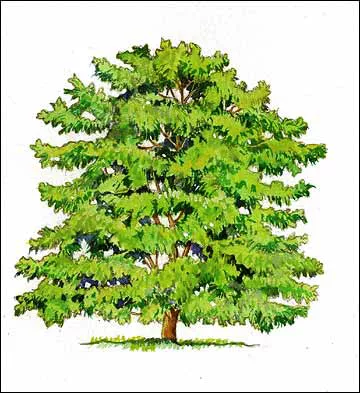How-to Select Trees by Shape

You don't have to be a tree expert to pick a tree by shape. Whether you want a cone-shaped tree or a tree with horizontal branches, we have tree ideas for you.
Columnar
Columnar trees are shaped like columns or cylinders, with branches of uniform length from top to bottom. They aren't necessarily narrow, but they appear to be because of the branching pattern. Many commonly known trees are available in columnar versions.
Examples: cherry, European hornbeam, Lombardy poplar, red maple, quaking aspen, sugar maple, tuliptree
Open-Head Irregular
The branching pattern of theses trees is irregular and random, creating an open, asymmetrical canopy shape. They offer wonderful shade, and after their leaves fall, their branch architecture creates dramatic silhouettes against a winter sky.
Examples: ash, buckeye, catalpa, hickory, pawpaw, sycamore (London Plane), silver maple, smoketree
Weeping
The branches of weeping trees droop downward and are covered with graceful, cascading foliage. These typically smaller, ornamental trees soften the hardscape. Many commonly known trees are available in a weeping form.
Examples: birch, cherry, crabapple, hemlock, katsura, larch, sourwood, willow
Pyramidal
These broad, cone-shaped trees have triangular canopies that are wider at the base and narrower toward the top. Many deciduous trees and conifers have this classic shape. The large ones are stunning on properties where they have room to grow.
Examples: American beech, American holly, baldcypress, blue spruce, cucumber magnolia, fir, linden, oak (pin and scarlet), sweetgum
Globe
The canopies of these trees, with their regular, rounded shape, are ideal for formal landscapes. Stately rows provide a strong linear feature, softened by the billow of their canopies. When alone on a spacious lawn, they make handsome specimens.
Examples: American hornbeam, American yellowwood, bur oak, black maple, flowering dogwood, hackberry, redbud
Fastigiate
These trees have an elongated, narrow, tapering profile and a strong vertical habit that draws the eye upward. When planted in rows, they serve beautifully as hedges to define boundaries, as windbreaks, and as effective screens against noise or undesirable views.
Examples: Arborvitae, baldcypress, European beech, ginko
Vase
Vase-shaped trees have canopies that work well near streets and sidewalks because they don't block the view of traffic or pedestrians. Branches grow at a sharp upward angle from the trunk, flaring outward at the tips. Canopies resemble upside-down triangles.
Examples: Boxelder, elm, fringetree, hawthorn, striped maple, zelkova
Horizontal Spreading
Trees with horizontal branches, even at the top of the canopy, can seem very wide. Usually massive, they overwhelm small properties and can dwarf single-story homes. But their spreading habit contrasts well with a narrow house.
Examples: Beech, Eastern redcedar, fir, honeylocust, hornbeam, Korean dogwood, larch, oak (red, white), witchhazel